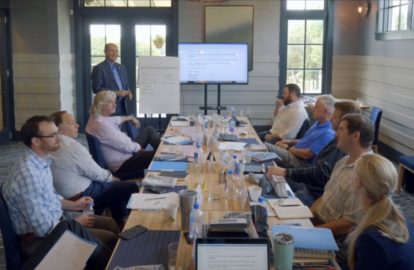“Your problem isn’t the real problem.” Futurist and technology expert, Daniel Burrus
Leaders face no shortage of challenges, but as renowned futurist Daniel Burrus says, “Whatever problem you’ve got… that’s not it. You’re smart; you would have solved it by now.” The problem isn’t the problem. It’s like the top layer of an onion–you’ve got to keep peeling it back. As hard-charging CEO Mark* discovered, with the right process and the right support, you can uncover the real problem. And, then, solving it is easy.
A Rising Star CEO
Mark is the epitome of a young, ambitious CEO, leading with vitality and energy. His results speak for themselves: he’s accelerated growth within his car dealership, and the $100 million organization is thriving. He’s doing everything right. Or nearly everything.
In a Vistage meeting, he brought up an issue that had been weighing on him for over a year. He needed to replace his controller, Suzy*, as she moved towards retirement. Mark’s question to his peers was: “Do I replace her with someone experienced, who brings a lot of knowledge to the table? Or do I opt for someone a year or two out of school, someone talented and eager to learn?”
Question Everything
As longtime Vistage member Tim McCarthy writes in Everything I Ever Needed to Know I Learned in Vistage, writes, “Process precedes success.” At the core of the Vistage process is questions. Each one peels away another layer of the onion. It’s not about the answers; most CEOs and executives already have the answers. They may be fragmented. They may be hidden. They may be hard to see. But they’re there. Questions help unearth them.
The best advice for a young CEO – or a veteran, for that matter – isn’t “advice” at all. It’s a well thought-out question. With this in mind, the group asked what Mark was looking for in a controller. With whom was he more comfortable dealing? What kind of skill level did he need?
The Problem That Wasn’t the Problem
As Mark answered the questions, something wasn’t ringing true. Something was “off” – an advantage of face-to- face meetings is that peers can tell. So we went back to the beginning: “Why do you really want to replace Suzy?”
Mark explained that, while a terrific lady, she was beginning to forget information and her performance was in decline. Her data wasn’t as timely or accurate as it should have been. He simply needed reliability, consistency, and results in this critical role. In bringing in a strong replacement, Mark could access the data he needed to grow his company even further. So what was keeping him from seizing that opportunity?
Through questioning, he eventually said, “My father hired Suzy 30 years ago. It might be disrespectful to him to let her go.”
We were getting closer. Next, we asked if he’d spoken to his father about the issue. He replied, “No, I can’t. I don’t know how to talk to my dad about this issue.”
There it was. Mark didn’t know how to talk to his father about this issue, how to discuss firing someone his dad hired as a young lady decades ago. That problem was the real problem. Once he peeled the onion down this far, the way forward was clear. He needed to talk to his father.
We asked him how he could approach the conversation, what he talked to his father about and what he didn’t, what setting could facilitate the conversation, and on and on. While the discussion would be difficult for Mark, the solution to the real problem was simple.
Solving the Right Problem
As Burrus says, “To solve impossible problems” – or merely difficult ones – “you gotta be working on the right ones.” Mark had a problem that wasn’t the problem. Through open-ended, intensive – yet supportive – questions from his peers, he was able to drill down until he reached the real issue. Only then could he solve it – and take his company to even greater heights.
*This name has been changed for confidentiality.


